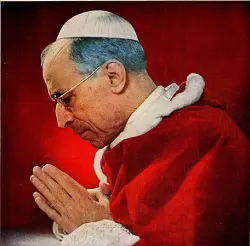The Breaking Of The Dams. Part I: “Il Papa Stupido”
I read around the (right) consideration that not all must have been good in pre-V II times; otherwise it would not be explained how V II could do so much damage in just a few years.
I will, therefore, try to make some considerations about this myself.
We tend to see a strong Church as a wonderful apparatus, eliminating sin from around it like a hoover gets rid of the dust. I am afraid it might not work that way.
Fallen nature being what it is, even a strong church can only be something similar to a strong dam, opposing a strong wall of faith to the immense quantity of sin pushing against it. You can stand at the bottom of the huge wall and observe its majesty, and you will certainly think the dam beautifully strong; but what you won’t see is the huge amount of water ceaselessly applying its pressure on the wall, and which would flood to the vale below if allowed.
Such was, in my opinion, the Church of that Great Pope, the Pastor Angelicus. An extremely strong dam, for sure; cared for by many trusted guardians; but still, with the huge mass of world sinfulness exerting a huge pressure against it. This pressure was growing and growing as the Western world left behind it the years of great deprivations (and, as always, strong faith) of the war and marched resolutely towards unprecedented prosperity and optimism; and, to an extent, unprecedented belief Religion is now not the basis for life, but an optional not really useful in times of advanced medicine and ever-growing individual security.
Strong as the dam is, the water behind it will always be immense, and will always be ready to flood everything if a leaked, no matter how small, is found.
The leak has a name: il papa buono; or, as I think it far more appropriate, il papa stupido. Pope John XXIII was really so dumb, that he thought a little leak would do no great harm, and the bit of water coming the other way would be a welcome refreshment and cleansing force for the dry, dusty, at times crusty walls of the old, majestic, very hard dam.
Fool.
The rest all followed from the initial madness: as it is in the nature of things, once the water found a small aperture it did not take long before the huge pressure, which had always been exerted (but was kept in check by the Pastor Angelicus and his very smart Church) caused a big leak, then a break, and a huge quantity of water naturally rushed the other side in a roaring waterfall. When Roncalli died too many were already those now tasting of the water, and desiring to shower in its roaring freshness.
Pope Roncalli had contracted two typical diseases of the age: the first was niceness, and the second a boundless, rather stupid optimism about the future. These diseases belied the traditional, realistic and dryly somber evaluation of the human shortcomings prevalent up to then. John XXIII was probably so dumb that he really believed in a new era of sort; as if humanity could transition to a new phase just as easily as the Soviet Union could transition from Stalin to Khrushchev or the US from Eisenhower to Kennedy.
Pope Roncalli is, therefore, the main – if unwitting – agent of the flood. But not he alone, of course. The flood came because of the original sin-laden water that had never ceased to apply its huge pressure on the Church, and which only the strong dam of a very fortunate series of excellent Popes (five of the last six rather stellar by any Church History standard) had kept in check for so long, and with such success. But human sinfulness is a huge weight to keep in check. The desire to “make peace with the world” is an extremely heavy temptation. The water will still be there pushing, pushing all the time…
Here ends Part I.
Part II will deal with what is, in my eyes, the second most important factor in the unfolding of the first, brutal stage of what was to become, as we can now safely say, an apocalyptic tragedy.
M
Posted on September 27, 2016, in Catholicism, Conservative Catholicism, Traditional Catholicism and tagged Pre-V II Church, V II. Bookmark the permalink. 9 Comments.





















The dam analogy is excellent. Thank you for a fresh insight.
This is one of your finest posts. I look forward to the next.
Mundy,
Wonderful analogy. It allows me to consider the errors while viewing a peaceful lake, (pre-flood). I can’t help but envision Our Lady’s Fatima message would’ve shored up the dam, but Roncalli said it did not pertain to the reign of his pontificate. Sigh…
“a very fortunate series of excellent Popes (five of the last six rather stellar by any Church History standard) had kept in check for so long, and with such success”
Great post! I would like to know who was the Pope (5 of 6) you consider not “so excellent”. Would it be Benedict XV? And what do you think about Pius XI?
It would certainly be Benedict XV.
Pius XI was, if you ask me, rather stellar…
M
“A little bread and wine does no harm.”
It’s worth it for waiting your fine article. Thanks. What do you actually think of this evil clown: illuminati, possessed heretic, false prophet and evil incarnate? I think he’s much more above all. Hope God will reveal his identity soon.
Satan’s biggest fart.
M
Pingback: The Breaking Of The Dams. Part II: The Education Revolution And The Religion Of Youth | Mundabor's Blog